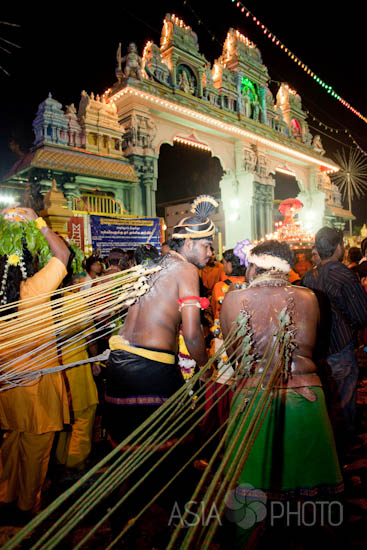 Devotees doing their penance in the form of pulling chariots using strings and hooks attached to their bodies.
Devotees doing their penance in the form of pulling chariots using strings and hooks attached to their bodies.
Commissioned by AsiaPhoto — Batu Caves, Malaysia, 2009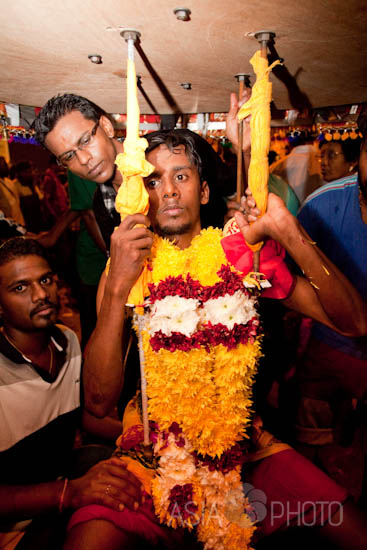 A kavadi bearer prepares himself for the vel kavadi dance. The vel kavadi is a altar made with wood and decorated with peacock feathers and weighs up to 50kg. They are attached to the bearer through hooks or spikes.
A kavadi bearer prepares himself for the vel kavadi dance. The vel kavadi is a altar made with wood and decorated with peacock feathers and weighs up to 50kg. They are attached to the bearer through hooks or spikes.
Commissioned by AsiaPhoto — Batu Caves, Malaysia, 2009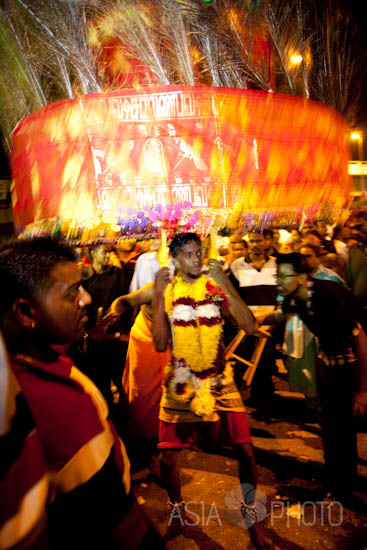 The vel kavadi attracts much attention from devotees and visitors alike due to its large size and its flamboyant decorations. Carrying a vel kavadi is seen as the ultimate form of penance due to the heavy burden and the multiple piercings involved.
The vel kavadi attracts much attention from devotees and visitors alike due to its large size and its flamboyant decorations. Carrying a vel kavadi is seen as the ultimate form of penance due to the heavy burden and the multiple piercings involved.
Commissioned by AsiaPhoto — Batu Caves, Malaysia, 2009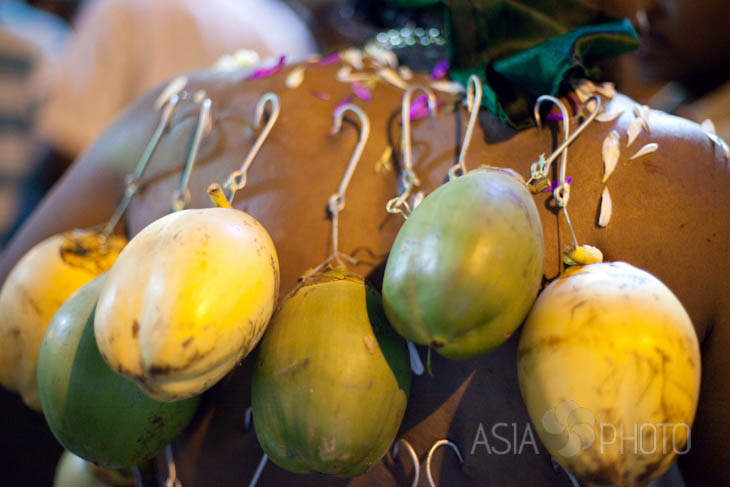 Many devotees also hook smaller items such as fruits and bells in their back as kavadi. Devotees say they feel no pain and shed no blood in their state of trance because of Lord Murugan's protection.
Many devotees also hook smaller items such as fruits and bells in their back as kavadi. Devotees say they feel no pain and shed no blood in their state of trance because of Lord Murugan's protection.
Commissioned by AsiaPhoto — Batu Caves, Malaysia, 2009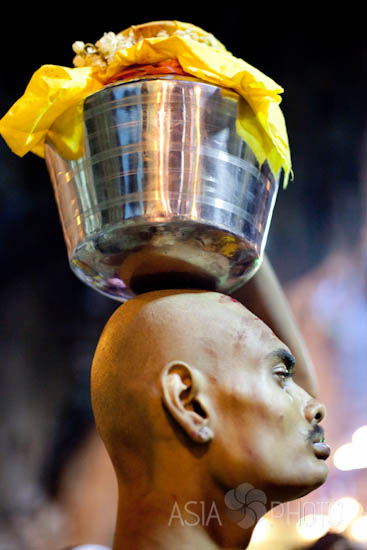 Not all kavadi involve physical torture; they can also be as simple as a milk jugs (paal kudam) carried on devotees' head, as women and even children often do. Those who are clothed usually dress in yellow and orange, the colours of Lord Murugan.
Not all kavadi involve physical torture; they can also be as simple as a milk jugs (paal kudam) carried on devotees' head, as women and even children often do. Those who are clothed usually dress in yellow and orange, the colours of Lord Murugan.
Commissioned by AsiaPhoto — Batu Caves, Malaysia, 2009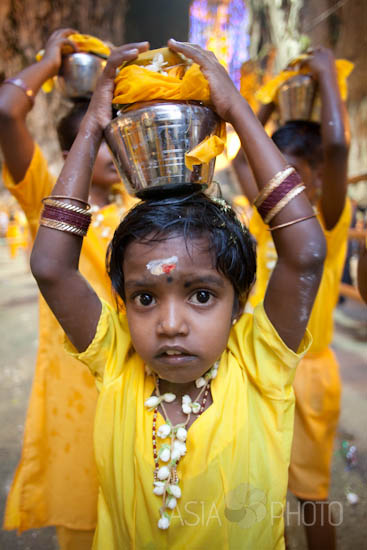 Not all kavadi involve physical torture; they can also be as simple as a milk jugs (paal kudam) carried on devotees' head, as women and even children often do. Those who are clothed usually dress in yellow and orange, the colours of Lord Murugan.
Not all kavadi involve physical torture; they can also be as simple as a milk jugs (paal kudam) carried on devotees' head, as women and even children often do. Those who are clothed usually dress in yellow and orange, the colours of Lord Murugan.
Commissioned by AsiaPhoto — Batu Caves, Malaysia, 2009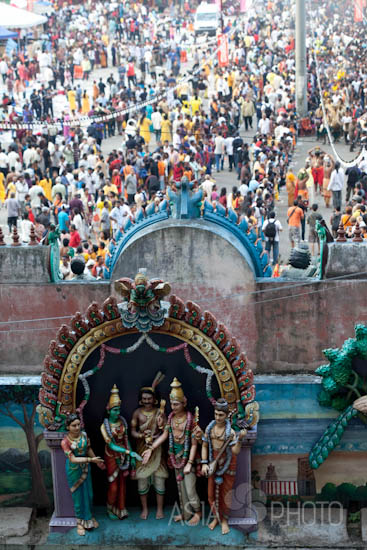 Batu Caves attract about 1.5m devotees and visitors yearly, mostly during the Thaipusam festival.
Batu Caves attract about 1.5m devotees and visitors yearly, mostly during the Thaipusam festival.
An estimated 1.2m visited the caves for Thaipusam in 2009.
Commissioned by AsiaPhoto — Batu Caves, Malaysia, 2009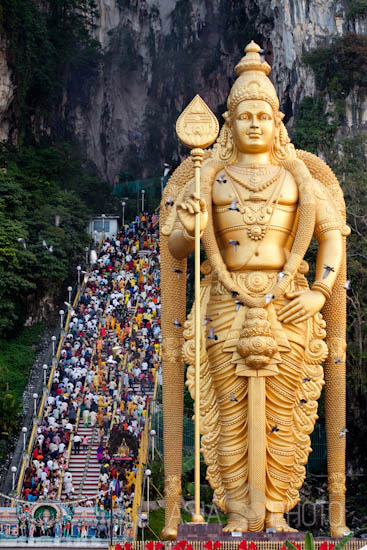 A 43m tall statue of Lord Murugan completed in 2006 stands beside the steep flight of stairs to the cave.
A 43m tall statue of Lord Murugan completed in 2006 stands beside the steep flight of stairs to the cave.
It is the tallest statue of the Hindu deity in the world.
Commissioned by AsiaPhoto — Batu Caves, Malaysia, 2009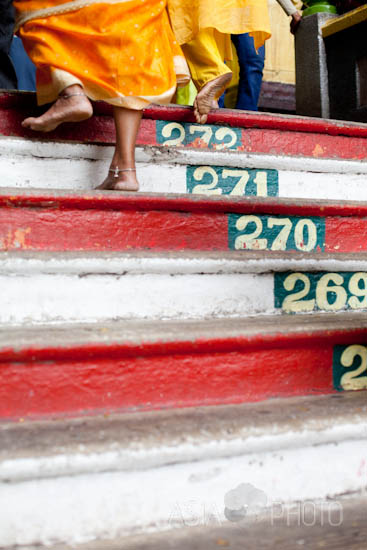 Carrying their kavadi, devotees scale the 100m high Batu Caves temple barefooted through 272 steps of stairs.
Carrying their kavadi, devotees scale the 100m high Batu Caves temple barefooted through 272 steps of stairs.
Commissioned by AsiaPhoto — Batu Caves, Malaysia, 2009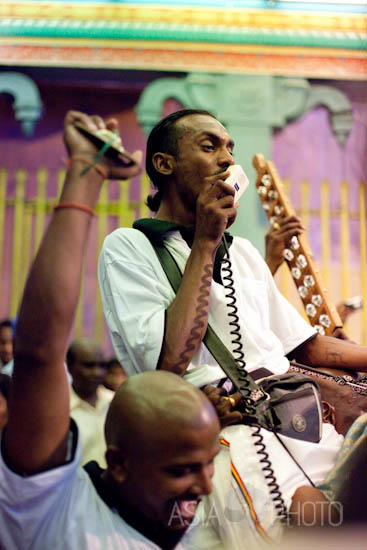 Music, which comes in the form of fast rhythmic beats, does not stop at the caves during Thaipusam.
Music, which comes in the form of fast rhythmic beats, does not stop at the caves during Thaipusam.
Commissioned by AsiaPhoto — Batu Caves, Malaysia, 2009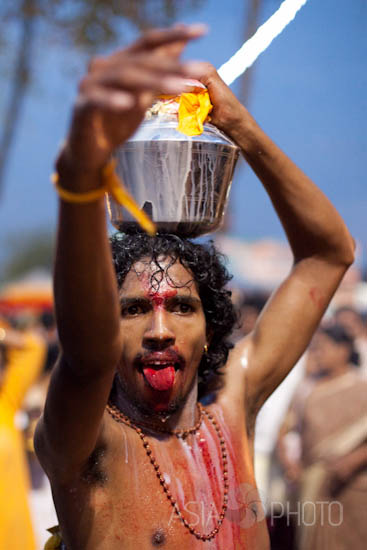 A devotee in trance dances to the fast beats while carrying his kavadi. Kumkumam, a bright red traditional Indian powder, is smeared over his tongue and body and used to give blessings to other devotees.
A devotee in trance dances to the fast beats while carrying his kavadi. Kumkumam, a bright red traditional Indian powder, is smeared over his tongue and body and used to give blessings to other devotees.
Commissioned by AsiaPhoto — Batu Caves, Malaysia, 2009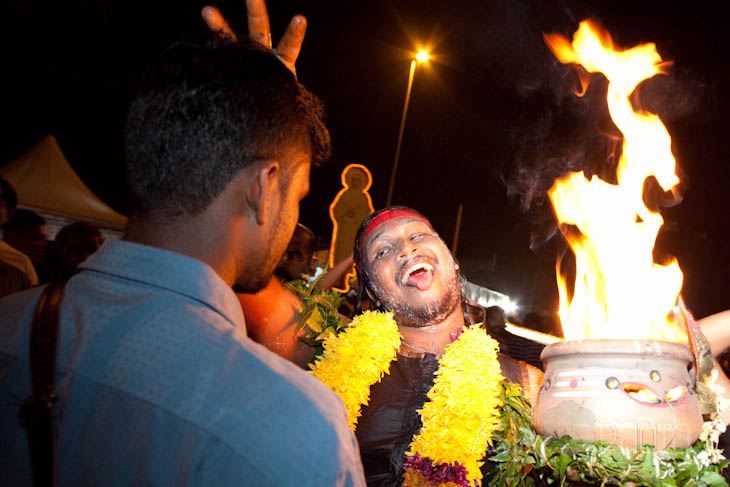 A devotee in trance with milk poured over his head. Pilgrims seek blessings from these devotees at the caves.
A devotee in trance with milk poured over his head. Pilgrims seek blessings from these devotees at the caves.
Commissioned by AsiaPhoto — Batu Caves, Malaysia, 2009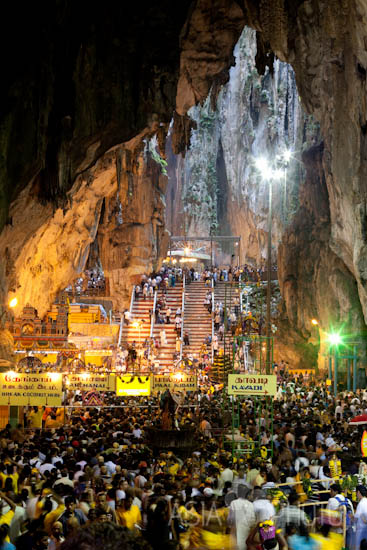 One of the three main caves atop the stairs, the Cathedral Cave is the tallest and houses the main Hindu temple.
One of the three main caves atop the stairs, the Cathedral Cave is the tallest and houses the main Hindu temple.
Commissioned by AsiaPhoto — Batu Caves, Malaysia, 2009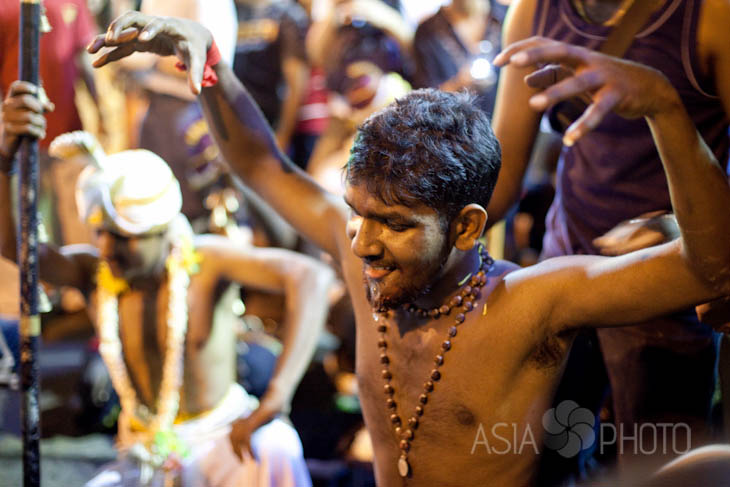 A devotee have his kavadi removed after completing his pilgrimage. The wounds are then treated with hot ash and lemon juice.
A devotee have his kavadi removed after completing his pilgrimage. The wounds are then treated with hot ash and lemon juice.
Commissioned by AsiaPhoto — Batu Caves, Malaysia, 2009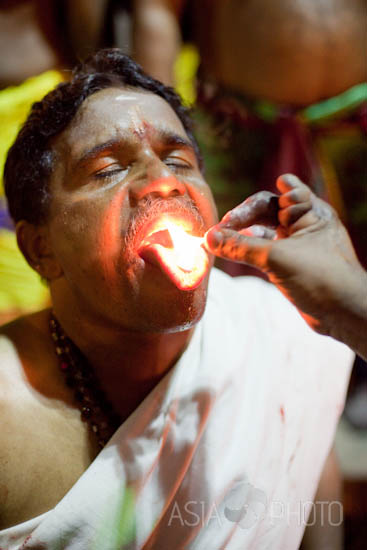 A ritual is conducted to bring a devotee out of his trance.
A ritual is conducted to bring a devotee out of his trance.
Commissioned by AsiaPhoto — Batu Caves, Malaysia, 2009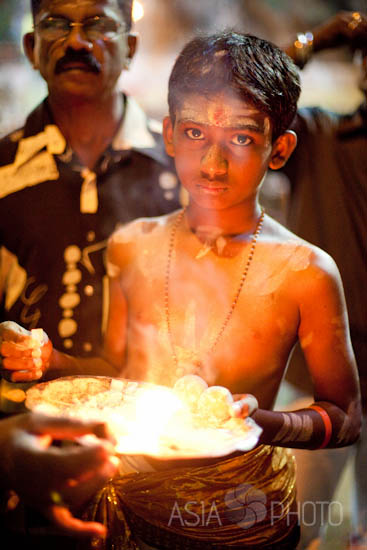 A young devotee carries a plateful of ash and fire used for blessings.
A young devotee carries a plateful of ash and fire used for blessings.
Commissioned by AsiaPhoto — Batu Caves, Malaysia, 2009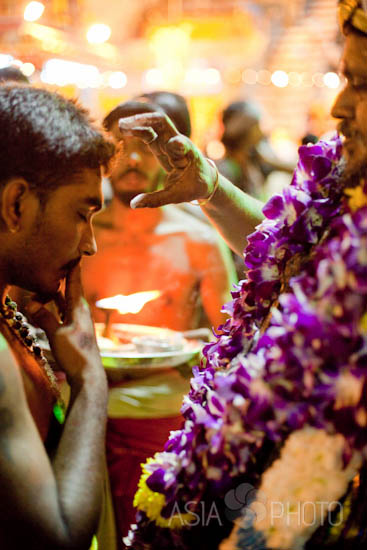 Devotees and visitors seek blessings from priests and kavadi bearers.
Devotees and visitors seek blessings from priests and kavadi bearers.
Commissioned by AsiaPhoto — Batu Caves, Malaysia, 2009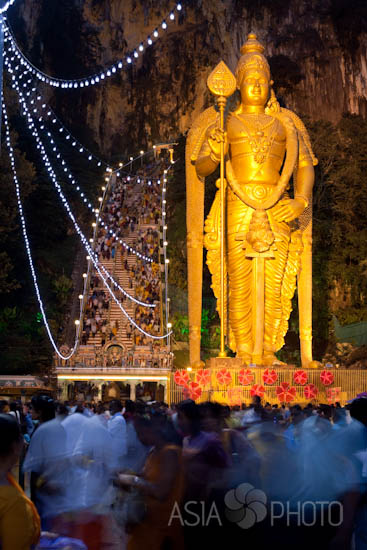 The festival continues through the night until the day after.
The festival continues through the night until the day after.
Commissioned by AsiaPhoto — Batu Caves, Malaysia, 2009
 Devotees doing their penance in the form of pulling chariots using strings and hooks attached to their bodies.
Devotees doing their penance in the form of pulling chariots using strings and hooks attached to their bodies.
 A kavadi bearer prepares himself for the vel kavadi dance. The vel kavadi is a altar made with wood and decorated with peacock feathers and weighs up to 50kg. They are attached to the bearer through hooks or spikes.
A kavadi bearer prepares himself for the vel kavadi dance. The vel kavadi is a altar made with wood and decorated with peacock feathers and weighs up to 50kg. They are attached to the bearer through hooks or spikes.
 The vel kavadi attracts much attention from devotees and visitors alike due to its large size and its flamboyant decorations. Carrying a vel kavadi is seen as the ultimate form of penance due to the heavy burden and the multiple piercings involved.
The vel kavadi attracts much attention from devotees and visitors alike due to its large size and its flamboyant decorations. Carrying a vel kavadi is seen as the ultimate form of penance due to the heavy burden and the multiple piercings involved.
 Many devotees also hook smaller items such as fruits and bells in their back as kavadi. Devotees say they feel no pain and shed no blood in their state of trance because of Lord Murugan's protection.
Many devotees also hook smaller items such as fruits and bells in their back as kavadi. Devotees say they feel no pain and shed no blood in their state of trance because of Lord Murugan's protection.
 Not all kavadi involve physical torture; they can also be as simple as a milk jugs (paal kudam) carried on devotees' head, as women and even children often do. Those who are clothed usually dress in yellow and orange, the colours of Lord Murugan.
Not all kavadi involve physical torture; they can also be as simple as a milk jugs (paal kudam) carried on devotees' head, as women and even children often do. Those who are clothed usually dress in yellow and orange, the colours of Lord Murugan.
 Not all kavadi involve physical torture; they can also be as simple as a milk jugs (paal kudam) carried on devotees' head, as women and even children often do. Those who are clothed usually dress in yellow and orange, the colours of Lord Murugan.
Not all kavadi involve physical torture; they can also be as simple as a milk jugs (paal kudam) carried on devotees' head, as women and even children often do. Those who are clothed usually dress in yellow and orange, the colours of Lord Murugan.
 Batu Caves attract about 1.5m devotees and visitors yearly, mostly during the Thaipusam festival.
Batu Caves attract about 1.5m devotees and visitors yearly, mostly during the Thaipusam festival.
 A 43m tall statue of Lord Murugan completed in 2006 stands beside the steep flight of stairs to the cave.
A 43m tall statue of Lord Murugan completed in 2006 stands beside the steep flight of stairs to the cave.
 Carrying their kavadi, devotees scale the 100m high Batu Caves temple barefooted through 272 steps of stairs.
Carrying their kavadi, devotees scale the 100m high Batu Caves temple barefooted through 272 steps of stairs.
 Music, which comes in the form of fast rhythmic beats, does not stop at the caves during Thaipusam.
Music, which comes in the form of fast rhythmic beats, does not stop at the caves during Thaipusam.
 A devotee in trance dances to the fast beats while carrying his kavadi. Kumkumam, a bright red traditional Indian powder, is smeared over his tongue and body and used to give blessings to other devotees.
A devotee in trance dances to the fast beats while carrying his kavadi. Kumkumam, a bright red traditional Indian powder, is smeared over his tongue and body and used to give blessings to other devotees.
 A devotee in trance with milk poured over his head. Pilgrims seek blessings from these devotees at the caves.
A devotee in trance with milk poured over his head. Pilgrims seek blessings from these devotees at the caves.
 One of the three main caves atop the stairs, the Cathedral Cave is the tallest and houses the main Hindu temple.
One of the three main caves atop the stairs, the Cathedral Cave is the tallest and houses the main Hindu temple.
 A devotee have his kavadi removed after completing his pilgrimage. The wounds are then treated with hot ash and lemon juice.
A devotee have his kavadi removed after completing his pilgrimage. The wounds are then treated with hot ash and lemon juice.
 A ritual is conducted to bring a devotee out of his trance.
A ritual is conducted to bring a devotee out of his trance.
 A young devotee carries a plateful of ash and fire used for blessings.
A young devotee carries a plateful of ash and fire used for blessings.
 Devotees and visitors seek blessings from priests and kavadi bearers.
Devotees and visitors seek blessings from priests and kavadi bearers. The festival continues through the night until the day after.
The festival continues through the night until the day after.